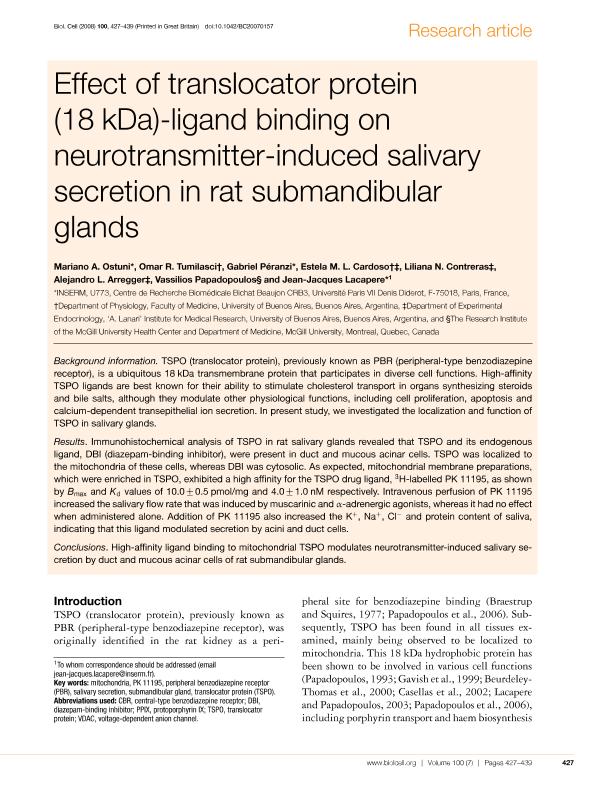Artículo
Effect of translocator protein (18 kDa)-ligand binding on neurotransmitter-induced salivary secretion in rat submandibular glands
Ostuni, Mariano; Tumilasci, Omar Rene ; Péranzi, Gabriel; Cardoso, Estela M. del Luján
; Péranzi, Gabriel; Cardoso, Estela M. del Luján ; Contreras, Liliana Noemí
; Contreras, Liliana Noemí ; Arregger, Alejandro Luis
; Arregger, Alejandro Luis ; Papadopoulos, Vassilios; Lacapere, Jean Jacques
; Papadopoulos, Vassilios; Lacapere, Jean Jacques
 ; Péranzi, Gabriel; Cardoso, Estela M. del Luján
; Péranzi, Gabriel; Cardoso, Estela M. del Luján ; Contreras, Liliana Noemí
; Contreras, Liliana Noemí ; Arregger, Alejandro Luis
; Arregger, Alejandro Luis ; Papadopoulos, Vassilios; Lacapere, Jean Jacques
; Papadopoulos, Vassilios; Lacapere, Jean Jacques
Fecha de publicación:
07/2008
Editorial:
Portland Press
Revista:
Biology Of The Cell
ISSN:
0248-4900
Idioma:
Inglés
Tipo de recurso:
Artículo publicado
Clasificación temática:
Resumen
Background information. TSPO (translocator protein), previously known as PBR (peripheral-type benzodiazepine receptor), is a ubiquitous 18 kDa transmembrane protein that participates in diverse cell functions. High-affinity TSPO ligands are best known for their ability to stimulate cholesterol transport in organs synthesizing steroids and bile salts, although they modulate other physiological functions, including cell proliferation, apoptosis and calcium-dependent transepithelial ion secretion. In present study, we investigated the localization and function of TSPO in salivary glands. Results. Immunohistochemical analysis of TSPO in rat salivary glands revealed that TSPO and its endogenous ligand, DBI (diazepam-binding inhibitor), were present in duct and mucous acinar cells. TSPO was localized to the mitochondria of these cells, whereas DBI was cytosolic. As expected, mitochondrial membrane preparations, which were enriched in TSPO, exhibited a high affinity for the TSPO drug ligand, 3H-labelled PK 11195, as shown by Bmax and Kd values of 10.0+− 0.5 pmol/mg and 4.0+− 1.0 nM respectively. Intravenous perfusion of PK 11195 increased the salivary flow rate that was induced by muscarinic and α-adrenergic agonists, whereas it had no effect when administered alone. Addition of PK 11195 also increased the K+, Na+, Cl− and protein content of saliva, indicating that this ligand modulated secretion by acini and duct cells. Conclusions. High-affinity ligand binding to mitochondrial TSPO modulates neurotransmitter-induced salivary secretion by duct and mucous acinar cells of rat submandibular glands.
Archivos asociados
Licencia
Identificadores
Colecciones
Articulos(IDIM)
Articulos de INST.DE INVEST.MEDICAS
Articulos de INST.DE INVEST.MEDICAS
Citación
Ostuni, Mariano; Tumilasci, Omar Rene; Péranzi, Gabriel; Cardoso, Estela M. del Luján; Contreras, Liliana Noemí; et al.; Effect of translocator protein (18 kDa)-ligand binding on neurotransmitter-induced salivary secretion in rat submandibular glands; Portland Press; Biology Of The Cell; 100; 7; 7-2008; 427-439
Compartir
Altmétricas



